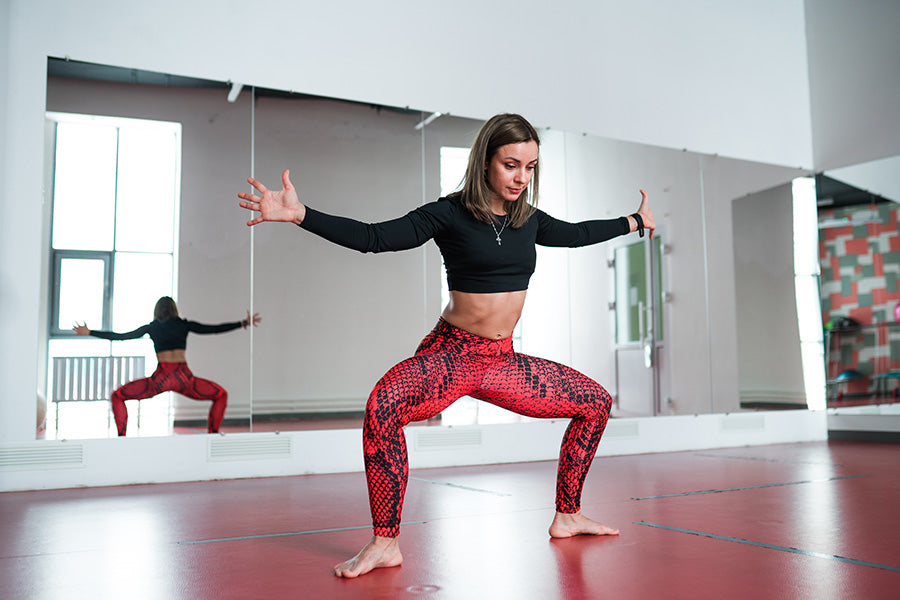The Plié squat should rank top of your list if you're looking for an effective fitness training exercise. Squats are a key exercise with countless benefits, including making you stronger, aiding muscle growth, and helping you become leaner.
Most people do some form of squatting numerous times throughout the day without even realizing it — sitting down and standing back up or getting in and out of your car are movement patterns that utilize squats.
The very versatile Plié squat, a great variation of the basic squat, can target various muscle groups while also helping to improve core strength and stability. As a bonus, this straightforward movement requires minimal equipment and can be modified to suit different fitness levels.
Plié squats offer ample rewards with just a few simple moves. When performed consistently with proper form, Plié squats provide great fitness benefits that will leave you feeling stronger and more confident!
Here's everything you need to know about Plié squats:
What is a Plié Squat?
If fitness training is on your agenda, chances are you've heard of Plié squats. This move builds leg strength, improves balance, and increases flexibility.
The squat itself helps target the quadriceps muscles in the front of the thigh, and while in the Plié position, fitness enthusiasts work their way through a series of steps involving an outward stance, bending at the knees, pushing through the heels of the feet back up to standing, and then a graceful release. You can even add weights for an extra challenge. Here's a series of steps to follow to perform a Plié squat:
- To begin, place your feet slightly wider than shoulder-width apart with your toes pointing at a 45-degree angle.
- From there, bend your knees and lower your torso while keeping your back straight and abs tight.
- Once you reach the desired depth, squeeze your glutes and return to the starting position.
By adding Plié squats to your workout routine, you target your glutes, quads, and hamstrings like traditional squats do and give special attention to the inner thighs.
Combined with healthy eating habits and some aerobic exercises, regular Plié squats can lead to leaner and more defined thighs, helping you achieve a strong, flexible, and more functional body overall.
Related Article: The Ultimate Inner Thigh Workout: 10 Best Inner Thigh Exercises for Women
Plié Squats Benefits
Plié squats come with tons of benefits. Here are a few important ones:
Train & Sculpt Your Inner Thighs
As mentioned above, Plié squats work the inner thighs and all the muscles worked by classic squats. As opposed to a classic squat, the distinct foot placement in a Plié squat works different muscles and permits your hips to open. By moving your legs into the Plié position, you tone your adductor muscles, commonly known as inner thigh muscles.
Adductors are usually neglected in most posterior chain exercises, but engaging them is crucial for functional strength and stability. Plié squats build stronger, functionally more adept legs by toning the much-neglected inner-thigh muscles.
Strengthen Glutes
Plié Squats are one of the most beneficial fitness training exercises you can add to your fitness routine. Not only do they work your quads and inner thighs, but also your glutes! This exercise is great for those looking to gain strength and tone up--making it perfect for fitness novices and experts.
Make sure that when doing Plié squats, you push your hips back and lower yourself down until the thighs are parallel to the floor — this is key for facilitating the necessary muscle activation in your glutes! With proper guidance and form, Plié squats can help strengthen your glutes and tone other muscles in the lower body.
In a world where most tasks are machine operated and don't get to be on our feet a lot, it becomes essential to work on glutes because sitting for too long and leaving your glutes unused for long periods can permanently damage them. Plié squats help by engaging and strengthening them more than a basic squat.
Related Article: Get Bigger Glutes: Extreme Butt Builder Workout
Improve Balance & Stability
Plié squats improve balance and stability a lot more than a basic squat. Why? Because for Plié squat, you adopt a new stance with your feet turned out at a 45-degree angle. This does require a whole new level of balance and stability.
It's challenging at first, but with practice, you'll become more stable in your core and lower body. Plié squats got their name from ballet, so no wonder the exercise is about stability and balance in an unusual position.
You Can Do Them Anywhere
Plié squats are especially awesome because you don't need any equipment, a bit of space, or your body weight, and you are good to go. Plus, this exercise can be done anywhere — at home, the gym, or even in your hotel room while traveling.
This makes Plié squats great for when you want a quick lower-body workout but don't have access to any equipment.
Plié Squat Variations & Alternatives
Here go some important alternatives and variations:
Plié Squat Jump

Plié squat jumps are a fantastic way to simultaneously improve your explosive power and muscular endurance. These squats help increase muscle power, which is how quickly you can generate force. If you want to improve your vertical jump or feel more graceful, give Plié squat jumps a try!
To do a jump Plié squat, follow all mentioned at the beginning of this article. However, when it's time to get back up straight, you do that in a jumping, explosive manner instead of straightening up slowly and gradually.
Plié Squat With Heels Raised

If you want to work your calves muscles, try Plié squats with your heels raised. A lot of balancing goes into this variation, but it's worth all the hard work and balancing act.
- Start with your feet wide apart and pointed outwards (just like a Plié squat).
- Then look straight ahead while engaging your core muscles for stability.
- Rise onto your tiptoes.
- Next, lower yourself into a squat position without lowering your heels.
- Stop a second for muscle engagement and stand back up.
- If keeping your heels in one place is too difficult, you can shift between raising and lowering your heels.
Plié Squat With Weights
Like other squats, you can add weight for greater muscle activation. The best would be a weight plate, but you can use dumbbells or kettlebells.
If you are experiencing knee pain or stress with Plié squats, there is a great alternative in a side lateral lunge.
Side Lateral Lunges

Although side lateral lunges work the same muscles, they engage one leg at a time instead of both, like Plié squats. You can perform them using only your body weight as resistance, holding dumbbells, or having a barbell on your back for an additional challenge.
No matter how you choose to do them, side lunges are an excellent knee-friendly alternative to regular squatting.
- With your feet set wide and toes pointed slightly out, lower your hips and bend one knee while pushing your hips back sinking down into one side.
- Keeping your weight on the heel of the planted foot, raise your arms in front of your chest as you descend.
- Stand back up by extending your knee and hips.
FAQs
1. How Many Calories Do Plié Squats Burn?
A more general way to look at how many calories you're burning during a workout is this: if you're working intensely, the average person will burn about 100 calories every 10 minutes. So in a moderate to intense workout that includes Plié squats, you should expect to burn around 100 calories per 10 minutes.
2. Do Plié squats pressurize your knees?
The Plié squat position involves your hips rotated outward. Although this could increase knee joint stress, it's not an uncommon sensation to feel pressure on the inside of the knee joint during a Plié squat.
You might even experience knee pain. When doing a Plié squat, some people have their feet turned out to form a straight line with their legs; however, this is not recommended.
Doing so puts unnecessary stress on the knees and can cause long-term damage. Instead, turn your feet out only about 45 to 60 degrees from your body to minimize any injury risk.
3. What's the difference between sumo and Plié squats?
The Plié squat and sumo squats are the same, often called by either name. With this variation of standard squats, you add a bit more work for the inner thighs and glutes.
4. Which squat is best for a bigger bum?
The sumo squat is ideal for working your glutes. With a wider stance, your hips will stay externally rotated to activate your glutes more, eventually helping to build a bigger bum.
The Bottom Line
Now that you know how to do a Plié squat and all the benefits that come with it, give it a try! This move is great for toning your legs and butt and can be done practically anywhere. Keep the proper form in mind while doing this exercise, and if you have any trouble, plenty of variations and alternatives might suit you better. So what are you waiting for? Get squatting!











